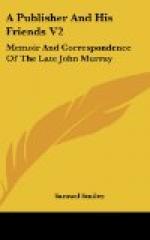Your Lordship’s faithful Servant,
JOHN MURRAY.
With reference to the foregoing letter we read in Lord Byron’s Diary:
“Mr. Murray has offered me one thousand guineas for ‘The Giaour’ and ‘The Bride of Abydos.’ I won’t. It is too much: though I am strongly tempted, merely for the say of it. No bad price for a fortnight’s (a week each) what?—the gods know. It was intended to be called poetry.”
The “Bride of Abydos” was received with almost as much applause as the “Giaour.” “Lord Byron,” said Sir James Mackintosh, “is the author of the day; six thousand of his ‘Bride of Abydos’ have been sold within a month.”
“The Corsair” was Lord Byron’s next poem, written with great vehemence, literally “struck off at a heat,” at the rate of about two hundred lines a day,—“a circumstance,” says Moore, “that is, perhaps, wholly without a parallel in the history of genius.” “The Corsair” was begun on the 18th, and finished on the 31st of December, 1813.
A sudden impulse induced Lord Byron to present the copyright of this poem also to Mr. Dallas, with the single stipulation that he would offer it for publication to Mr. Murray, who eventually paid Mr. Dallas five hundred guineas for the copyright, and the work was published in February 1814. The following letters will give some idea of the reception it met with.
John Murray to Lord Byron.
February 3, 1814.
MY LORD,
I have been unwilling to write until I had something to say, an occasion to which I do not always restrict myself. I am most happy to tell you that your last poem is—what Mr. Southey’s is called—a Carmen Triumphale. Never, in my recollection, has any work, since the “Letter of Burke to the Duke of Bedford,” excited such a ferment—a ferment which, I am happy to say, will subside into lasting fame. I sold, on the day of publication—a thing perfectly unprecedented—10,000 copies.... Gifford did what I never knew him do before—he repeated several passages from memory.”
The “Ode to Napoleon Bonaparte,” which appeared in April 1814, was on the whole a failure. It was known to be Lord Byron’s, and its publication was seized upon by the press as the occasion for many bitter criticisms, mingled with personalities against the writer’s genius and character. He was cut to the quick by these notices, and came to the determination to buy back the whole of the copyrights of his works, and suppress every line he had ever written. On April 29, 1814, he wrote to Mr. Murray:
Lord Byron to John Murray.
April 29, 1814.
I enclose a draft for the money; when paid, send the copyrights. I release you from the thousand pounds agreed on for “The Giaour” and “Bride,” and there’s an end.... For all this, it might be well to assign some reason. I have none to give, except my own caprice, and I do not consider the circumstance of consequence enough to require explanation.... It will give me great pleasure to preserve your acquaintance, and to consider you as my friend. Believe me very truly, and for much attention,




